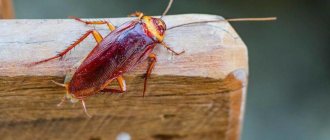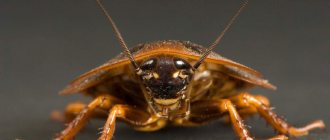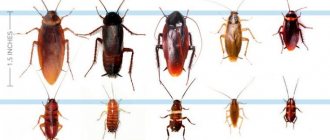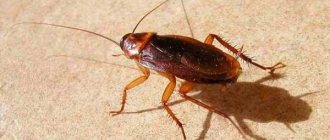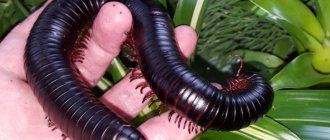A flying cockroach from an insectophobe's nightmares
This post has already been read 1889 times!
Good day to my dear readers. I’m sure each of us has heard the funny word “cucaracha” at least once. This is the name of an effective and easy-to-use remedy for cockroaches, and it is also the name of a humorous song in Spanish. “Cucaracha” translated from Spanish means “cockroach” - this is what government troops were called during the Mexican Revolution at the beginning of the 20th century.
In addition, the cucaracha is the name of the flying American cockroach. So, let's find out what Cucaracha is, where you can find the flying giant insect and how to use the drug.
A flying cockroach from an insectophobe's nightmares
Imagine for a moment an ordinary and familiar Prussian. Introduced? Did you feel disgust and a desire to quickly kill the bastard? Now sympathize with the Americans, who have the same one, only flying and up to 5 cm long. This creature, called the “cucaracha,” is actually nothing more than an American cockroach. Africa is considered its homeland, and since 1695 the flying giant has lived in North America.
Fortunately, we don’t have any of these here, but if you’re planning to travel around America or Europe, be on your guard and don’t accidentally bring a couple of individuals home - our compatriots will have enough of ordinary cockroaches. Below I will tell you how, using a product named after a comic song and an American cockroach, you can successfully fight against domestic Prussians.
How does this product with a strange name work?
The drug contains two active substances - cypermethrin and malathion. The first is a powerful pesticide that poisons the body by penetrating through the chitinous integument. Malathion accelerates the action of cypermethrin, leaving the individual no chance. In addition, the product sticks to the legs and abdomen of the cockroach, so one individual upon returning to the nest can infect the entire population.
Death occurs on average half an hour after contact with the poison. As you can see, Cucaracha helps to quickly and effectively destroy insects in the apartment. Now I will tell you how to use this product and in what form the manufacturer produces it.
Cucaracha emulsion
The most common format of the product is an emulsion, packaged in bottles of 50 and 1000 ml. A small bottle will be enough to treat an apartment, and a large bottle will be useful for disinsection of large industrial premises. Each package contains instructions, but just in case, we’ll talk in detail about how to use Cucaracha against cockroaches:
- First, prepare the apartment for disinfestation: take children and pets away, hide toys and dishes, take away plants and flowers, put food in the refrigerator. Before use, dilute the emulsion in water in the following proportion: 3 ml of emulsion per 1 liter of water. It's better to take cool water. After the solution is ready, do not forget to wear personal protective equipment: gloves, goggles, a respirator and clothing that covers the entire body. Are you packed? Let's start processing. Using a spray bottle, we apply the solution in corners, on baseboards, on the back surfaces of furniture, in the ventilation shaft and sewer riser - in general, in all those places where cockroaches live or can crawl. After all insect habitats have been generously sprayed with the solution, you need to open the windows and leave the apartment for 4-5 hours.
Cucaracha is highly poisonous to people and animals, so do a thorough cleaning when you return. Do not forget to listen to how you feel: nausea, dizziness, headache and weakness can become symptoms of intoxication. In this case, you must immediately seek medical help.
Deadly Cucaracha granules
In addition to the emulsion, the product is produced in granular form in packages of 30 and 100 g. I have recommendations for you on the use of granules to achieve a quick effect:
- Put on gloves and carefully open the packet of poison. Place a few granules (about a teaspoon) on a backing (you can use a piece of paper, but usually special plastic backings are sold complete with the poison). Leave poisonous treats in places where cockroaches are likely to be: near the trash can, on kitchen cabinets, under the refrigerator, etc.
One individual, having been in contact with the granules, will provoke an entire epidemic, destroying the entire population of cockroaches. The complete death of all individuals will take two to three days.
Please note - the product is highly toxic, therefore it is prohibited:
- pour the granules into the drain; leave poison in places where children and pets can find it; use food containers to place granules - such dishes will have to be thrown away; work with granules without appropriate protection - rubber gloves, a respirator and long sleeves.
Cucaracha - all the pros and cons
Like any pest control product, Cucaracha has a number of advantages and disadvantages. Let's first consider the positive aspects of the product:
- Maximum effectiveness - the poison leaves no chance for a single individual thanks to the combination of two active substances in its composition. Speed of disinsection - complete destruction of all cockroaches will take a maximum of three days. Cheap and accessible - the drug is sold in hardware stores and is inexpensive. Lack of smell - Cucaracha has such a subtle aroma that you will only notice it if you sniff it specifically. As you understand, it is prohibited to do this, otherwise you risk getting poisoned. Versatility - with the help of Cucarachi you can defeat not only cockroaches, but also woodlice, silverfish, bedbugs, ants and, in general, any insects that have entered your home. As you can see, the product has all the qualities of an ideal pest control agent. Now let's look at its disadvantages. The first and main drawback is that Cucaracha is very toxic. If your pet licks the solution or eats a few granules, your pet could be killed. A person should exercise no less caution to avoid the hazardous health consequences of intoxication. Inconvenient to use - the emulsion must be diluted with water, look for a suitable container; The granules need to be poured onto a substrate and placed around the apartment. This is a serious drawback, especially compared to modern insecticidal traps, which simply need to be taken out of the package and left indoors.
Actually, these are all arguments against the use of this product in the fight against domestic insects - Cucarachi has many more advantages. Most importantly, do not forget about personal protective equipment, carefully read the instructions for use on the packaging and strictly follow all the manufacturer’s recommendations.
After disinfestation, do not forget to ventilate and wash the apartment, and also listen to your health - if the alarming symptoms of poisoning do not go away for more than two hours, this is a serious reason to consult a doctor to prevent serious health consequences. Subscribe to blog updates so as not to miss important and interesting information. See you soon! Sincerely, blog author Mikhail Leshchenko
Source
Educational resource about culture, science and art
Author of the article: Sergey Kuriy Article from the “Cultural Zoology”
Looking at the lonely swarming cockroach, I often caught myself thinking: “What? He's okay. Against the backdrop of many insects, this is quite a pretty specimen.” However, as soon as you see a moving crowd of cockroaches, not a trace remains of your former sympathy.
But sometimes the same can be said about people... So let's step away from the feeling of disgust for a while and look at the cockroach as another wonderful creation of nature.
Invasion from the south
“So the Cockroach became the winner, And the ruler of forests and fields. The animals submitted to the mustachioed one. (May he fail, damned one!)” (K. Chukovsky)
Of course, you may not like cockroaches, but we must not forget that cockroaches are a very ancient order of insects respected by biologists. There were no birds, no animals, no dinosaurs when ancient cockroaches were already roaming the forests from which coal was later formed 300 million years ago.
A modern cockroach and an imprint of its fossil relative.
Judging by the number of fossil finds, they were then the dominant group among insects. Of all the modern orders of insects, only dragonflies are older than cockroaches. In addition, even a non-specialist, looking at the prints of cockroach ancestors, can easily recognize them as his annoying homebodies, because the appearance of the barbels has hardly changed. Except that back then they all flew and had a long ovipositor, which has now atrophied. Despite the ability to fly, already in those ancient times cockroaches chose a secretive lifestyle, crawling in the rotting forest floor.
Throughout its long history, the spread of cockroaches was only hindered by cold. These insects are extremely thermophilic. About 80% of species live exclusively in the tropical zone and in the fresh air. Only a few “hardened” wild species managed to make a breakthrough to the north, for example, the steppe and Lapland cockroaches, which manage to overwinter as eggs or larvae in the forest floor and under the bark of trees.
However, out of four thousand species of baleen, our citizen is interested in at best two - but which ones!
It must be said that the Eastern Slavs were already lucky - their cockroaches were the last to be “tamed.” But civilized insects conquered Southern and Western Europe no later than 400 years ago. First, black cockroaches entered the “European Union”, and then they were pushed out by red cockroaches. Where they migrated from - from Africa or Asia - is not really known, but that from the southern regions is certain. Cockroaches reached Russia only in the second half of the 17th century. The black one came from Asia (presumably from Turkey), and the red one was brought in backpacks and sleeve cuffs by Russian soldiers returning from Germany after the Seven Years' War. Hence the second name of the red cockroach - “Prusak”. Serbs and Croats also nicknamed him with a German flavor - “Buba Swab” (Swabia, like Prussia, is a German territory). Either in retaliation, or for some other reason, the Germans themselves often call the red cockroach “hare.”
The red one turned out to be quicker than the black one, leaving him only the lowest floors and basements. But the black one looks much more impressive: it is twice as large as a Prussian, its body shines like varnish, and an impressive belly sticks out from under the small elytra. Black cockroaches live longer than red cockroaches; one larval development can last for four years.
In the 17th century, along with Cuban sugar cane, another species of cockroach arrived in Europe - the American one, but it did not compete with the black and red ones.
“Domestic cockroaches” from left to right: American, black and Prussian.
The word “cockroach” itself (Ukrainian “targan”) is most likely of Turkic origin. The Tatars had such a privileged stratum - the Tarkhans, whose representatives were exempt from paying taxes. The city of Tmutarakan, known from “The Tale of Igor’s Campaign,” as historians suggest, was located on the Taman Peninsula and received its name not because a multitude of cockroaches lived in it. It is believed that it belonged to the Khazars and at first it was nicknamed “Taman-Tarkhan”, which in Turkic meant “city exempt from taxes.” One way or another, in the end the Russians awarded Turkic titles to countless hordes of mustachioed domestic parasites.
I. Dobrodomov: “The name of the tax-free “pet” and uninvited resident of the house COCKROACH, it turns out, comes from the very honorable Turkic title tarkhan.”
It is worth saying that at first the cockroach did not cause such disgust as it does now, and Russian peasants even loved it in their own way. It was a kind of symbol of home well-being for them - they say, if there are cockroaches in the house, then it means it is warm and satisfying. This is clearly expressed in the sayings collected by Dahl: “If there was a hut, there would be cockroaches”, “Black cockroaches breeding - to profit”, “Prussians multiplying - to good”, “Cockroaches crawling out of the house - to a fire.” There was even a custom - when moving to a new house, they were sure to let in cockroaches from the old house. And many immigrants to Siberia and the Far East even took their faithful guests with them. They even tried to use cockroaches... for medicinal purposes. They dried them, crushed them into powder, made a tincture and hoped to use it to cure pleurisy, dropsy, ulcers... It is no secret that cockroaches were also infused with vodka, which was called “cockroach”.
However, over time, these numerous parasites began to annoy people - especially after they learned that cockroaches are carriers of dysentery, worm eggs and many other unpleasant diseases. These insects began to feel especially at ease after the appearance of high-rise buildings with a network of garbage chutes and ventilation shafts, which the mustachios used no worse than Bruce Willis. It was then that people declared a merciless, but often unsuccessful war on the cockroaches.
An anecdote on the topic: Two cockroaches are eating: - Yesterday I went to a nearby restaurant: clean, orderly, not a speck anywhere! - Why are you saying nasty things at the table? At least let me eat in peace!
Magic structure of a cockroach
“Love will pass. Passion will deceive you. But the magical structure of the cockroach is devoid of deception. Oh, splayed cockroach legs, there are six of them! They are talking about something, they are scribbling in the air, Their outlines are full of secret meaning... Yes, there is something in a cockroach, When it moves its paw and sways its antenna.” (N. Oleynikov)
It is difficult to fight a cockroach due to its remarkable vitality, unpretentiousness and fertility. Despite the fact that the female is fertilized only once, during her short life she is able to lay eggs several times and give birth to 200–400 heirs. The female carries the eggs on her belly in a special package called an ooteca.
Empty, torn ootheca mean that forty white cockroach larvae have already left them (they will gradually grow and after a series of moults they will darken).
The diet of cockroaches is extremely varied: they eat paper, glue from book bindings, soap, ink and watercolors, shoe polish and leather shoes, flowers and the corpses of other insects (including their dead fellows) - in general, everything except glass, stone and metal. Some impudent creatures are even capable of gnawing off the skin epidermis from the faces of sleeping people. But this is only in case of extreme hunger strike. In general, of course, they will prefer white bread and beer, which the cockroach especially loves, to soap. Well, if there is no food at all, a cockroach can live without it for about 40 days. The lack of water is more difficult to tolerate, therefore, when fighting cockroaches, it is important not to leave garbage cans open and wipe the dishes and sink dry.
Anecdote: One drunken man complains to another: “Damn, there are a lot of cockroaches in my house - we got them!” They ruined all the food and don’t let me sleep! And most importantly - they are not poisoned by anything!!! - And you say several times before going to bed: “There’s nothing to eat!!!” The man did just that. At night he wakes up, looks - several thousand cockroaches are standing by the bed, and the main one says: - Listen, master, we brought you something to eat...
These insects usually spend daylight hours in shelters and crevices (some have already taken a fancy to the latest technology such as computers). Active life begins at night, and the rustling of cockroaches' legs echoes throughout the apartment. To navigate in the dark, cockroaches use not only sensitive long whiskers, but also an extensive system of invisible but odorous paths, which they themselves mark with their pheromones. These lines are quite durable and cannot simply be washed off with water. That’s why cockroaches always know their “evacuation plan” in case of alarm.
If you often see mustachioed tenants during the day, it means there are already too many of them. Trampling a cockroach is also not easy - it is a very fast runner. So, the Prussian runs away at a speed of 1 km per hour. And its Colombian relative runs four times faster. By the way, the Colombian cockroach is also the largest among cockroaches - its length is almost 10 cm, width - 4.5 cm. It would be worth mentioning the Sarawak cockroach from the island of Kalimantan, the larvae of which prefer to escape from danger by diving to the bottom of the reservoir. Well, nature protected the cockroach Prosoplecta semperi even better, making it outwardly practically indistinguishable from the inedible ladybug.
The agility of cockroaches is also reflected in folklore. Let us remember the proverb “A lie walks on cockroach legs,” that is, it spreads quickly and in all directions. And in the slang there were also such interesting verbs as “cockroach” and “cockroach”, related to the sphere of sex - apparently, very fast and energetic sex.
It is not surprising that the sprinting talents of cockroaches have found their application in such fun as cockroach racing. They say this sport was invented by sailors who were bored during long voyages. In Russia, cockroach racing gained enormous popularity in the Moscow taverns of the 19th century. Mostly large black cockroaches, tinted with yellow paint to make them more visible, took part in the races. Passions around the races raged no less than at the hippodrome. They said that one merchant managed to lose all his butcher shops on a cockroach sweepstakes.
In M. Bulgakov’s play “Running,” the constantly mentioned cockroach races became an allegorical reflection of the fate of the fleeing Russian white emigration.
M. Bulgakov “Running”: “KHLUDOV. ...And I myself rode comfortably. Huddled in a corner of the compartment, neither I offend anyone, nor anyone me. In general, it’s twilight, Your Excellency, like in the kitchen. COMMANDER IN CHIEF. I don't understand you, what are you saying? KHLUDOV. Yes, it happened when I was a child; once I entered the kitchen at dusk, there were cockroaches on the stove. I lit a match, teal, and they ran. Take the match and go out. I hear them with their paws - shur-shur, purr-purr. And here too - darkness and rustling. I look and think: where are they running? Like cockroaches in a bucket. From the kitchen table - bang!..”
The next reason why cockroaches are difficult to exterminate is their resistance to poisons. The longhorned beetle population is capable of developing immunity to a new poison in just six generations, and their generations change quite quickly. Even the formidable Pentagon admitted its powerlessness to remove cockroaches. And even if an atomic bomb explodes in this very Pentagon, the cockroaches will survive it. Among animals, they are among the most resistant to high doses of radiation.
The only reliable anti-cockroach remedy is frost. These people from the south stop reproducing and become numb even at 15 degrees Celsius. I remember when I was still little, my family successfully got rid of the Prussians in this old way - they opened all the windows in the house in winter and moved in with their aunt for a couple of days. In Dahl's dictionary, such a freezing procedure even had its own name - “cockroach.” But cockroaches are good in a private house; in high-rise buildings this is impossible. Therefore, you have to use all sorts of poisons and pencils, or even better, call sanitary disinfectors. It is advisable to carry out cleaning together with your housemates, since cockroaches are quite well-known deserters.
Jokes:
- I do not know what to do. The cockroaches were tortured. They are running around everywhere - there is no peace. - Buy some chalk for cockroaches. - Does it help? - Certainly. You see, they’re sitting in the corner, drawing...
A man called the sanitary and epidemiological station, they say, come, I have cockroaches, otherwise I found out that they are contagious and spread all sorts of infections. Well, they came, they sprayed, they left. The next day, he calls there again and complains, like, why are the cockroaches still running around. And in response to him, good-naturedly: “Don’t worry, they are no longer contagious!”
But these are jokes, but here is the real truth. While some people don’t know how to get rid of cockroaches, others… get them. Not Prussians, of course, but exotic Madagascar cockroaches - fat, beautiful and extremely clean. They live a long time (up to 2-3 years), reproduce poorly (15-20 larvae per life), and for reproduction they need an extremely favorable microclimate - 25 degrees Celsius. Therefore, the invasion of Madagascar cockroaches is unlikely to threaten our apartments...
The Madagascar cockroach is a kind of six-legged hamster.
Literary cockroaches
REACTION COCKROACH
“La cucaracha, la cucaracha Ya no puede caminar, Porque no tiene, porque le falta Marihuana que fumar...”
This incendiary song flowed in the 1920s and 30s from the horns of many gramophones and gramophones. Its text existed in so many variations that usually only the word “cockroach” remained from the original, which is how the Spanish “Cucaracha” is actually translated. It's hard to believe that this cheerful tune was born during the bloody years of the Mexican Revolution of 1910-19. in the detachments of the peasant army led by Francesco “Pancho” Villa - a sort of Mexican daddy Makhno.
Villa fought against the government forces of President Victoriano Carranza. It was Carranza’s supporters who were nicknamed “cockroaches” for their long mustaches, and the original version of “Cucarachi” has an openly mocking tone. Here is the literal translation:
“Cockroach, Cockroach can no longer walk, Because he doesn’t have, because he doesn’t have enough Marijuana to smoke.
The Carransists have retreated, They have retreated to Perot, And they can go no more, Entangled in their mustache.
And from Carranza’s beard I will make a bandage, To tie it on Señor Francesco Villa’s sombrero.”
COCKROACH DESPOTE
“Suddenly from the gateway a terrible giant, red-haired and mustachioed Ta-ra-kan! Cockroach, Cockroach, Cockroach! (K. Chukovsky)
At the beginning of the 20th century, the cockroach was so annoying to the population that they began to perceive it as a small indestructible despot, before whom even the two-legged “crown of nature” was powerless. This image found its complete embodiment in the famous poetic fairy tale of Korney Chukovsky, where, with the help of an exaggerated suffix, the insect turns into a real monster - the Cockroach - arrogant, insatiable, demanding that other animals sacrifice their young to it.
It's great that the children's poet didn't turn the cockroach into a giant horror movie monster. The cockroach has quite realistic dimensions, its power rests only on total fear, on intimidation, before which elephants and wolves, bulls and rhinoceroses surrender. In general, another illustration of the saying “Fear has big eyes.” The sparrow, which has not succumbed to cockroach propaganda, kills the despot with a simple peck on the forehead.
“...Cockroach, cockroach, cockroach, Liquid-legged little bug. And aren't you ashamed? Aren't you offended? You are toothy, You are fanged, But you bowed to the little one, And you submitted to the little booger!”
Among those who like to read contexts from texts, there is still an assertion that Chukovsky, in a veiled form, depicted you-know-who in the image of a mustachioed dictator. The stupidity of such a statement simply lies on the surface. Firstly, the fairy tale was written in 1923, when the struggle for the place of the dying Lenin was just beginning, and the positions of the mustachioed Stalin were no stronger than the positions of the same mustachioed Trotsky and Kamenev, and the completely beardless Zinoviev. Secondly, even under Stalin, “Cockroach” was published freely and in considerable editions. Well, and thirdly, Chukovsky was always extremely cautious about such striking criticism of the authorities, and the authorities are extremely sensitive to such criticism.
Here Mandelstam in his poem “We live without feeling the country beneath us...” brought out the image of the leader of nations in a very recognizable way: “The cockroach’s whiskers laugh, / And his boots shine...”. And when the authorities found out about this, the reaction followed immediately.
VICTIM COCKROACH
“...You, trouser-wearing scoundrel, Know that a dead cockroach is a martyr of science, And not just a cockroach.” (N. Oleynikov)
A cockroach can be looked at not only as a despot, but also as a silent victim. The most tragic cockroach was brought out in a poem of the same name by Nikolai Oleinikov, a colleague of the literary group OBERIU. The epigraph of this poem, “A cockroach got into a glass,” refers us to Dostoevsky, or more precisely, to the hero of his novel “Demons” - the vulgar poet Captain Lebyadkin.
F. Dostoevsky “Demons”:
“...You ask, madam: “why?” The answer is at the bottom of this fable, in fiery letters!..
...Once upon a time there lived a cockroach, a cockroach from childhood, and then it fell into a glass full of fly-eating...
- Lord, what is it? - Varvara Petrovna exclaimed. “That is, when in the summer,” the captain hurried, waving his arms terribly, with the irritable impatience of an author who is being prevented from reading, “when flies crawl into a glass in the summer, fly-eating occurs, any fool will understand, don’t interrupt, don’t interrupt, you’ll see, you’ll see.” ... (he kept waving his hands).
A cockroach took the place, the flies began to murmur, our glass was very full, they shouted to Jupiter. But while they were screaming, Nikifor, the most noble old man, approached...
I haven’t finished this yet, but anyway, in words! - the captain cracked, - Nikifor takes the glass and, despite the scream, throws out the whole comedy, flies and cockroaches, into the tub, which should have been done long ago. But notice, notice, madam, the cockroach does not complain! Here is the answer to your question: “why?” - he cried, triumphantly: - “Ta-ra-kan does not complain!” “As for Nikephoros, he depicts nature...”
The cockroach also appears as a non-complaining, powerless experimental victim in Oleinikov’s poem, written in 1934. This is a classic example of the artistic aesthetics of the OBERIUTs, where frivolity, irony and parody are strangely intertwined with the deep seriousness of the topic, with a feeling of existential horror and the meaninglessness of existence. The poem “Cockroach” is permeated with such gloomy banter. And if Lebyadkin’s cockroach is destroyed by ruthless and indifferent Nature, then Oleinikov’s insect is the victim of a cold-blooded scientific experiment. “There is no soul,” says science, and therefore the death of a cockroach is especially cruel and senseless.
“A cockroach is sitting in a glass, sucking a red leg. He got caught. He's in a trap. And now he is awaiting execution.
He glances with sad eyes at the sofa, where the vivisectors sit with knives and axes.
He is busy at the table with a ladle, wiping the tools, and muttering to himself the song “The Daring Troika.”
It's hard for a monkey to think, There are no thoughts - he sings. A cockroach sits in a glass, sucking a red leg.
The cockroach pressed against the glass And looks, barely breathing... He would not be afraid of death, If he knew that there was a soul.
But science has proven that the soul does not exist, that the liver, bones, lard - this is what forms the soul.
There are only articulations, and then connections.
It is impossible to resist the conclusions of science. The cockroach, squeezing his hands, prepared to suffer.
Now the executioner approaches him, And, having felt his chest, He finds under the ribs What needs to be pierced.
And having pierced it, it knocks the Cockroach on its side like a pig. He neighs loudly and bares his teeth, like a horse.
And then the Vivisectors rush to him in a crowd. Some use tongs, others gut the Cockroach with their hands.
One hundred and four instruments tear the patient apart. A cockroach dies from injuries and wounds.
He suddenly grows cold, His eyelids do not tremble... Then the villains came to their senses and retreated back.
Everything in the past is pain, adversity. There is nothing else. And groundwater flows out of it.
There, in the crack of a large closet, abandoned by everyone, alone, the Son babbles: “Dad, dad!” Poor son!
But his father doesn't hear him, Because he's not breathing. And standing over him is the shaggy, daring Vivisector, ugly, hairy, with tongs and a saw.
You, trouser-wearing scoundrel, know that a dead cockroach is a martyr of science, and not just a cockroach.
The watchman with a rough hand will throw him out of the window, and our little darling will fall headfirst into the yard.
On the trampled path, near the porch itself, he will raise his legs and wait for the sad end.
His bones are dry The rain will water His blue eyes The chicken will peck.”
It is extremely unlikely that Oleinikov was familiar with the work of Franz Kafka - the works of the Austrian writer were practically unknown in the USSR at that time. And yet, the images and mood of Kafka’s story “The Metamorphosis” (1916), according to many literary scholars, are surprisingly consonant with Oleinikov’s poem. In "Metamorphosis" it all begins with a senseless and cruel accident. One morning, the “little Austrian man” traveling salesman Gregor wakes up in the form of... an ugly insect. Researchers of Kafka's work claim that this insect was precisely a cockroach. The horror lies in the fact that the author describes this fantastic situation in rather everyday everyday language. And what worries Georg most of all is not the transformation itself, but the fact that he is trying to cope with his new body in order to go... to work, because it is the main source of income for his poor family.
F. Kafka “Metamorphosis”: “It turned out to be easy to throw off the blanket; It was enough to inflate the stomach a little, and it fell by itself. But things got worse from there, mainly because it was so wide. He needed arms to get up; but instead he had many legs that did not stop moving randomly and which he also could not control. If he wanted to bend any leg, it first stretched out; and if he finally managed to accomplish with this leg what he had in mind, then the others, as if having broken free, came into the most painful excitement. “Just don’t stay in bed unnecessarily,” Gregor said to himself. ... “... Mr. Manager,” Gregor exclaimed, losing his composure and, out of excitement, forgot about everything else, “I’ll open it immediately, this minute.” A slight malaise and an attack of dizziness did not give me the opportunity to get up. I'm still lying in bed now. But I have already completely come to my senses. And I'm already getting up. A moment of patience! I'm still not as good as I thought. But it's better. Just think what a misfortune! ...And why didn’t I notify the company about this! But you always think that you can overcome the disease on your feet. Mister Manager! Spare my parents! After all, there is no basis for the reproaches that you are making to me now; They didn’t say a word to me about it. You probably haven't seen the latest orders I sent. Yes, I’ll also leave on an eight-hour train; a few extra hours of sleep have bolstered my strength...”
But all that the hero faces is horror, misunderstanding and growing disgust towards him. Mutilated by his father and abandoned by his family, he dies silently, never understanding what happened. His corpse, like the corpse of Oleinikov’s cockroach, is disdainfully thrown into the trash...
And yet these cockroaches evoke pity in the reader. It turns out that you can feel sorry for cockroaches too...
Author: Sergey Kuriy First published in the magazine “Time Z” No. 2/2007 (April)
And the cucaracha! (large and black cockroach), as well as the other two introductions to the animal world of Africa.
Dabb lived with us for all 5 years and we, unable to part with our beloved animal, decided to take him to Moscow. To transport it across the border, they put it in a tube and took it in hand luggage. Upon arrival at Sheremetyevo, customs cleared the tube and asked what it was we were bringing. A stuffed lizard, we said. By taking the dabba out of the tube, we proved that the lifeless animal is definitely a stuffed animal. The calculation was simple - at temperatures below +20, cold-blooded creatures hibernate. Ours, therefore, fell asleep for the time being. In general, he lived with us for a long time. Under the refrigerator.
I spent every summer in the pioneer camp “Vostok 20” (this means he was 20 years old) on the shores of the Mediterranean Sea. When he was at Vostok 1, he rested there, being the same age as me - Mikhail Taratuta. Remember the program “America with Taratuta”?
One day our squad went to watch the dawn. Having met the dawn, we went down to the seashore, where a local resident was catching sea urchins. He explained that he catches them to eat, and what they eat is caviar. He cut open a hedgehog for each of us and gave it some caviar to try. The caviar was bright orange. Over the next two weeks, the entire squad came down with an undiagnosable illness. The camp was closed for quarantine. For some reason, out of 30 people, I was the only one who didn’t get sick. Although honestly, he swallowed the hedgehog and didn’t spit it out like everyone else. This was my third acquaintance with the animal world of Africa.
During the quarantine, I was transferred to the senior squad. It was much more interesting there! They were all adults! Already a year older. At night they told horror stories. It was terribly interesting. I remember that before lunch every day we had to sing songs about Lenin. I don’t know who came up with the idea of doing this before lunch. Probably those who wanted to undermine the foundations of Soviet power. A very subtle move. I was terribly hungry and therefore I hated Lenin even more (I also hated him because I had to sing about him). It was impossible not to sing - we are pioneers. On the way to the cafeteria, we collected soda and beer caps. The lids were beautiful and often found previously unseen. They collected entire collections. We were forbidden to pick up any nasty things from the ground, but we still picked them up. We also picked up transferable tattoos from “chewing gum”, which for some reason were lying in abundance along the way to the same dining room (the road passed outside the camp territory). Those who were found to have them transferred to their hands were given a severe reprimand. Vicious bourgeois habits in children! How is it possible! During my entire stay in Algeria, I never tried the chewing gum itself. We weren’t allowed to - we are pioneers. We were lucky - we had the opportunity to collect caps, candy wrappers and inserts when no one had thought about them yet. Only later did this abundance come to our country. And in Africa all this was easily accessible. It was possible to swim only if the water temperature was +22 or more. Every morning the camp doctor went to measure the water temperature. If it was lower, we didn’t swim. We hated the doctor too. The children wanted to swim! By the way, that’s where I learned to swim.
In Algeria we all missed the Union. All the children were jealous of those who were going home. Returning to the Union was tantamount to returning to a magical land. Unlike adults. We didn't understand them. Upon returning, in the courtyard I secretly pressed my lips to the ground. I spat for a long time. The earth tasted disgusting. Not sugar, I thought, and this immediately sobered me up - why was I so eager to go back? But before that there were still 5 long years. Often we were taken to Roman ruins - the entire north of Algeria was in the ruins of Roman cities. Since then I have seen enough of them and, when traveling, I rarely visit them.




